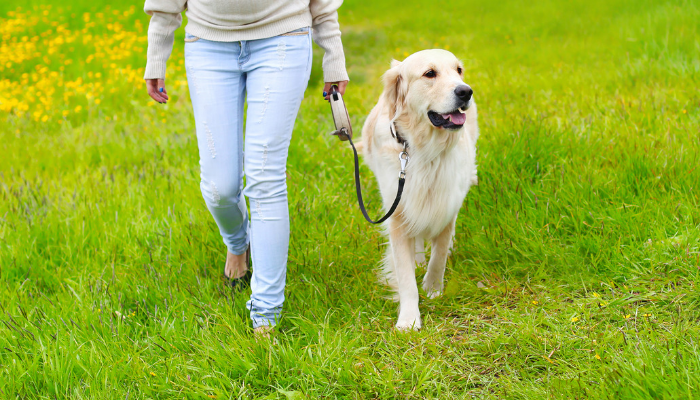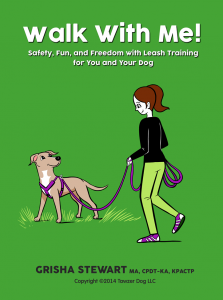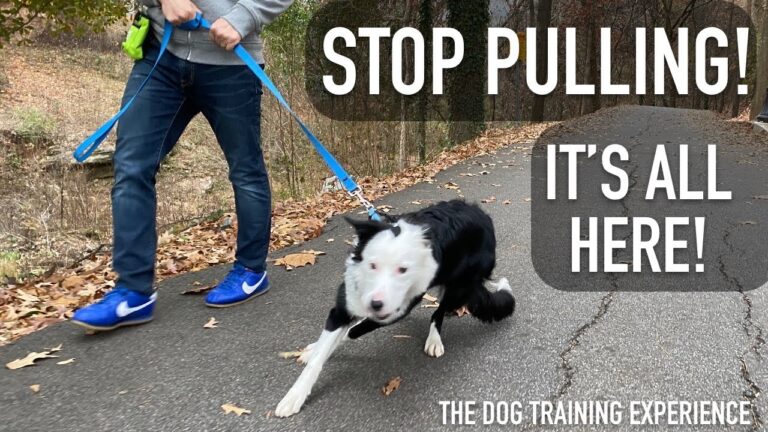To stop your dog from pulling on the leash, use positive reinforcement training techniques and maintain a consistent walking routine. By rewarding your dog for walking beside you and using tools like a front-clip harness, you can encourage loose leash walking.
This method is effective and humane in teaching your dog proper leash manners. Walking your dog should be an enjoyable experience for both you and your furry friend. However, if your dog constantly pulls on the leash, it can be frustrating and make walks less pleasant.
This guide will provide you with practical tips and techniques to help you stop your dog from pulling on the leash, allowing you to enjoy peaceful and enjoyable walks with your canine companion. By implementing positive reinforcement training and following a consistent routine, you can effectively address your dog’s leash pulling behavior.
Understanding Leash Pulling
Stop your dog from pulling on the leash by understanding leash pulling. Discover effective techniques to train your dog and establish better walking habits.
One of the most common issues dog owners face is leash pulling. It can turn a peaceful walk into a frustrating experience for both the owner and the dog. Understanding why dogs pull on the leash and the effects it has on them is the first step in addressing this behavior.
Why Dogs Pull On The Leash
There are several reasons why dogs pull on the leash:
- Excitement: Dogs are naturally curious and excitable creatures. When they see something that catches their attention, like a squirrel or another dog, they may instinctively try to chase after it.
- Exploration: Dogs love to explore their surroundings, and when they’re on a leash, their options are limited. Pulling allows them to investigate interesting scents or objects they come across.
- Impatience: Some dogs are simply impatient and want to move at a faster pace than their owners. They may pull on the leash to try and rush ahead.
The Effects Of Leash Pulling On Dogs
Leash pulling can have negative effects on dogs, both physically and mentally. Some of these effects include:
- Neck and throat injuries: Constant pulling on the leash can strain the neck and throat of a dog, leading to injuries like muscle strains or tracheal damage.
- Restricted breathing: Dogs that pull excessively on the leash may experience difficulty breathing, as the pressure on their necks restricts their airways.
- Behavioral issues: Leash pulling can contribute to the development of behavioral issues such as aggression or fear towards other dogs or people. It can also make the dog more difficult to control in various situations.
- Reduced bond with the owner: When a dog constantly pulls on the leash, it can create tension and frustration between the dog and the owner. This can affect the bond and trust they share.
Understanding why dogs pull on the leash and the negative effects it has on them is crucial in finding effective solutions to stop this behavior. By addressing these underlying reasons and using positive reinforcement techniques, you can teach your dog to walk calmly on a leash, creating a more enjoyable experience for both of you.
Training Techniques
When it comes to stopping your dog from pulling on the leash, effective training techniques are essential for both your dog’s safety and your own enjoyment while walking. By implementing positive reinforcement, loose leash walking, redirecting attention, and utilizing treats and rewards, you can transform your dog’s behavior and make walks more pleasant for both of you.
Positive Reinforcement
Positive reinforcement is a powerful way to teach your dog proper leash manners. When your dog walks calmly beside you without pulling, offer verbal praise, petting, or a small treat to reinforce this behavior. Always reward your dog immediately after they exhibit the desired behavior to strengthen the connection between the action and the reward.
Loose Leash Walking
Loose leash walking involves teaching your dog to walk without tension on the leash. Start by using a front-clip harness or head halter to discourage pulling. When your dog pulls, stop walking and wait for the leash to relax before continuing. Consistency is key: reinforce good behavior with rewards, and be patient as your dog learns to walk calmly by your side.
Redirecting Attention
When your dog starts to pull on the leash, use redirecting attention to shift their focus back to you. Encourage them to look at you by using a verbal cue or offering a toy or treat to regain their attention. This technique helps to break the habit of pulling and reinforces the importance of staying connected with you during walks.
Using Treats And Rewards
Consider using treats and rewards as powerful motivators for teaching leash manners. Keep small, easy-to-eat treats handy during walks and offer them intermittently for good behavior. This positive association encourages your dog to stay at your side and reinforces the concept that walking calmly on the leash leads to rewards.
Choosing The Right Equipment
When it comes to stopping your dog from pulling on the leash, choosing the right equipment is essential for successful training. Different types of leashes and collars, as well as harnesses, offer various benefits to help control your dog’s pulling behavior.
Different Types Of Leashes And Collars
Standard Leash: This traditional leash is made of nylon or leather and is suitable for dogs who walk well on the leash. It offers reliability and control.
Retractable Leash: Provides flexibility and freedom for your dog within a certain distance, but it can be challenging to control for dogs that pull.
Martingale Collar: Designed for dogs that tend to slip out of regular collars, this collar tightens when the dog pulls, preventing escape without choking the dog.
Prong or Pinch Collar: Not recommended for most dogs, as it applies pressure around the dog’s neck when they pull, potentially causing harm and discomfort.
Harnesses And Their Benefits
Back-clip Harness: The leash attaches to a ring on the dog’s back, distributing pressure more evenly and effectively reducing pulling. It’s suitable for smaller and well-behaved dogs.
Front-clip Harness: With the leash attachment at the dog’s chest, this harness discourages pulling by redirecting the dog’s direction. It’s ideal for strong pullers and larger dogs.
Head Halters: These are designed to control the dog’s head and muzzle, redirecting their attention and preventing pulling. However, they may require gradual acclimation for some dogs.

Credit: www.puppyleaks.com
Common Mistakes To Avoid
Learn how to prevent your dog from pulling on the leash by avoiding these common mistakes. Follow these guidelines for a successful training experience: keep sentences brief, vary your phrases, and write in an SEO-friendly, active voice.
Using Punishment Or Force
Using punishment or force as a method to stop your dog from pulling on the leash may seem like a quick solution, but it can actually do more harm than good in the long run. Pulling on the leash is often a sign that your dog is excited or curious, and using punishment or force can create fear and anxiety in your furry friend. Rather than resorting to these harsh techniques, it’s essential to focus on positive reinforcement and reward-based training methods. By utilizing treats, praise, and gentle guidance, you can teach your dog to walk calmly by your side without causing any distress.Not Being Consistent With Training
Consistency is key when it comes to training your dog to stop pulling on the leash. One of the most common mistakes dog owners make is not being consistent with their training efforts. Dogs thrive on routine and structure, so it’s crucial to establish clear rules and expectations from the beginning. Ensure that everyone in your household is on the same page when it comes to training techniques and consistently reinforce the desired behavior. This means not allowing your dog to pull on the leash during walks, even when you may be in a rush or distracted. With time and patience, your furry companion will learn that walking politely on a leash is the norm.Not Providing Enough Exercise
A tired dog is a well-behaved dog, and lack of exercise can contribute to excessive pulling on the leash during walks. Dogs are naturally active creatures, and they need regular physical and mental stimulation to stay happy and healthy. If your dog doesn’t get enough exercise, they may have built-up energy that leads to pulling and lunging on the leash. To prevent this, make sure to provide your dog with ample opportunities for exercise. Take them on daily walks, engage in play sessions, or even consider enrolling them in an obedience class or dog sport. A tired dog is more likely to walk calmly on a leash, making your walks together a pleasant experience for both of you.In conclusion, when it comes to stopping your dog from pulling on the leash, it’s essential to avoid common mistakes. Instead of resorting to punishment or force, focus on positive reinforcement and reward-based training methods. Be consistent with your training efforts, establish clear rules and expectations, and ensure everyone in your household follows the same approach. Additionally, provide your dog with enough exercise and mental stimulation to prevent built-up energy that can contribute to pulling on the leash. By avoiding these common mistakes and using effective training techniques, you can enjoy peaceful and enjoyable walks with your beloved furry companion.Additional Tips And Tricks
To improve your dog’s leash manners, try using treats to reward them for walking by your side. Consistent training and positive reinforcement can help your dog learn to walk without pulling. Additionally, consider using a front-clip harness or gentle leader to provide better control during walks.
Here are some additional tips and tricks to help you stop your dog from pulling on the leash. These techniques can be used in combination with the previous methods we discussed to effectively tackle this issue.
Gradual Desensitization
One effective technique to prevent your dog from pulling on the leash is gradual desensitization. This involves gradually exposing your dog to the triggers that make them pull while ensuring they remain calm and focused. Start by introducing your dog to the trigger at a distance where they don’t show any signs of pulling. Each session, gradually decrease the distance until your dog can be near the trigger without pulling. Repeat this process with different triggers to generalize the behavior.
Seeking Professional Help
If your dog continues to pull on the leash despite your efforts, seeking professional help can be beneficial. Professional dog trainers or behaviorists can assess your dog’s specific needs and develop a customized training plan. They have the expertise to identify the underlying causes of pulling and can provide you with effective techniques and strategies to address the issue comprehensively.
Using Distraction Techniques
Incorporating distraction techniques can be helpful in redirecting your dog’s attention and preventing pulling on the leash. Carry treats or toys with you during walks to divert their focus from distractions, such as other animals or interesting scents. Whenever you notice your dog starting to pull, use a command like “focus” or “watch me” to regain their attention. Reward them with a treat or praise when they respond appropriately, reinforcing the desired behavior.
Remember, training your dog to stop pulling on the leash requires patience, consistency, and positive reinforcement. By utilizing a combination of techniques like gradual desensitization, seeking professional help, and incorporating distraction techniques, you can help your furry friend become a well-behaved walking companion.

Credit: grishastewart.com

Credit: m.youtube.com
Frequently Asked Questions On How To Stop Your Dog From Pulling On The Leash
How Can I Teach My Dog To Stop Pulling On A Leash?
Teaching your dog to stop pulling on a leash requires consistent training and positive reinforcement. Start by rewarding your dog for walking calmly beside you and redirect their attention when they start pulling. Use a harness instead of a collar, so it doesn’t put pressure on their neck.
Gradually increase the distance and distractions during walks to reinforce good behavior.
Why Does My Dog Pull On The Leash During Walks?
Dogs pull on a leash because they are excited or trying to explore their surroundings. It can also be a result of pent-up energy or lack of proper training. They may see pulling as a way to get to something they want or as a means of control.
By teaching them proper leash manners, you can help them understand that pulling is not acceptable behavior.
What Equipment Can Help Stop My Dog From Pulling On The Leash?
Using the right equipment can make a significant difference in curbing your dog’s pulling behavior. A front-clip harness can give you better control and redirect their attention towards you. A head halter can also be effective, but it requires proper introduction and training.
Avoid using prong or choke collars, as they can cause discomfort or injury to your dog.
Conclusion
To wrap up, leash pulling can be frustrating, but with the right techniques and consistent training, you can teach your dog to walk calmly by your side. Remember to start with proper equipment, use positive reinforcement, and be patient. By maintaining a consistent and positive approach, you’ll soon enjoy peaceful and enjoyable walks with your well-behaved furry companion.
Happy training!



